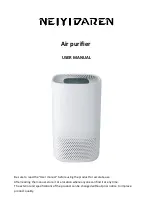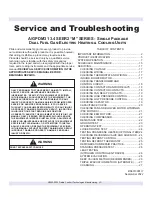
5.0 MAINTENANCE
This cleaning can be done mechanically or chemically. In chemical cleaning, a caustic
solution is pumped through the heat exchanger, which attacks dirt, slime and mineral
deposits and flushes them away. Chemicals can be recommended by water treatment
specialists, but it is important to rinse the system throughly after cleaning before the
chemicals attack the metal surfaces.
Condenser tubes may be mechanically cleaned by first draining the condenser water,
then removing the condenser heads and brushing each tube individually with a tube
cleaning brush until clean. For best results, always remove both heads before cleaning
the tubes. Replace the heads, being careful to properly position gaskets, and refill the
system with water.
Head gaskets need not be renewed after each head disassembly operation. Gaskets
should and must be renewed if they are physically disfigured or otherwise deteriorated.
(New gaskets are available from the factory).
INSPECT CAREFULLY.
5.3.3 TUBE REPLACEMENT
If your water-cooled condenser ever experience a tube failure, the tube can be replaced
without removing the vessel from its installed location (provided tube removal space is
available). Please contact Dunham-Bush Sales representative if tube replacement is
required.
5.4 WATER TREATMENT
Below is three of the major problems with water treatment and the suggested controlling
chemical:
Problems
Controlling Chemical
Remarks
1.) Scaling water
Phosphate compound
Acidic water
2.) Corrosion
Glossy phosphates, Chromate and Nitrates
Alkaline water
3.) Algae and slime
Chlorine, Bromine Pentachlorphenate, Copper sulphate
or Potassium permanganate
-
Water treatment should be undertaken by a qualified and competent water treatment specialist.
5.5 TIGHTENING OF PULLEY SET SCREW
Apply one or two drops of thread locked 243 to the engagement area of set screws before
tightening to the pulleys according to the recommended torque.
Set Screw Size
Tightening Torque (NM)
5/16
13
3/8
26







































